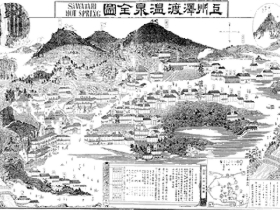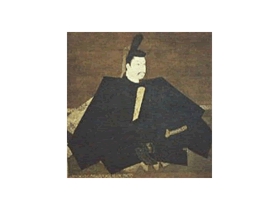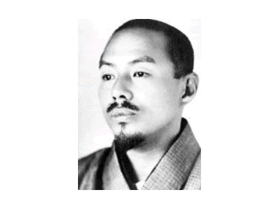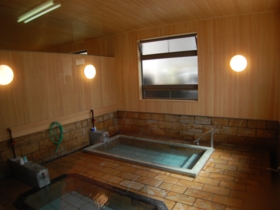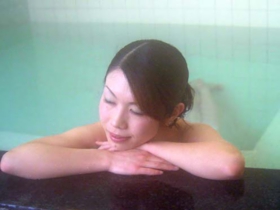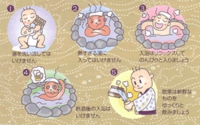
Hidden Treasure
Fresh-flowing, natural spring water since the Jomon period
Since the Jomon period (circa 1000 BC), Sawatari has had hot springs.
A land among nature, this has always been an easy place for people to live.
Rich in history, Kiso no Yoshinaka and Yoritomo Genji healed their fatigue in Sawatari.
Sawatari is a land that was loved by greats such as scholar Choei Takano, physician Sotei Fukuda, writer Bokusui Wakayama, and more.
People Associated with Sawatari
Yoritomo Minamoto(1147~1199)
<Yoritomo made Sawatari famous as “Naoshiyu of Kusatsu”>
In the second year of the Kenkyu period (1191), Yoritomo hunted around the foot of Mt. Asama. On his return, he stopped at Kusatsu, but because of the strong acidity of the water there his skin was damaged. After soaking in the baths of Sawatari and noticing his damaged skin had been healed, he dubbed Sawatari “Naoshiyu of Kusatsu,” with naoshiyu meaning the onsen that heals.
Bokusui Wakayama(1885~1928)
<Kuresaka pass was loved by Bokusui>
In his college days, Wakayama traveled to Gunma eight times to visit his friends. Among these, three were trips to Agatsuma.
In the 11th year of the Taisho period (1922), during his third trip to Gunma, Wakayama went from Shinshu to Kusatsu, and traveled through the Kuresaka Pass to Nikko. He published a novel about this trip in Taisho 13 (1924) entitled “Minakami Kiko”.
In the first half of his travel log, while going from Hanashiki to Kuresaka, he mentions Sawatari in an important scene. He also composed many poems about this trip in his novel named “Yamazakura no Uta”.
Bokusui composed his poem named “Kareno no Tabi” at the Kuresaka pass. In the 32nd year of the Showa period (1957), a group dedicated to Bokusui’s memory built a monument at the Kuresaka Pass with this poem inscribed on it. The monument is a symbol of Kuresaka pass.
Choei Takano(1804~1850)
<Choei Takano visited to Sawatari>
Choei Takano was a scholar of Dutch learning in the late Edo period. He was born in Mizusawa, Iwate. He studied Dutch avidly under the tutelage of Genpaku Sugita. After that, he became the pupil of Choshuku Yoshida. He went to Nagasaki in year eight of the Bunsei Period (1825), and he entered a Narutaki school and studied under Philipp Franz von Siebold. He studied the ecology of whales and was awarded the title of doctor. Doctors in Agatsuma who felt deadlocked by the Sino-Japanese traditional medicine, led by Soutei Fukuda, invited Takano to teach them the use of Western medicine in the 2nd year of Tenpo (1832). After that, Takano visited Sawatari again, or so it was written in Fukuda’s diary. Thus it was that Western medicine began to be used in Agatsuma. Takano produced pupils such as Keisaku Takahashi, Sozo Yanagida, and more.
Later in his life, Takano was imprisoned for his novel “Yume Monogatari.” He escaped, and as a fugitive his pupils sheltered him, or so it is told.
There are many episodes about Takano and Agatsuma. The Bantsuri Bridge over the Bebino River is purported to be named such because Takano enjoyed fishing there at night. In Japanese, ban means evening and tsuri means fishing.
Benefits of Sawatari Onsen
Sawatari was established as a spa 800 years ago. Rain water from half a century ago percolates deep underground, soaking up minerals for over 40 years. The resulting spring water gushes out at over 55ºC at the source.
○Temperature : 55℃
○Electric coductivity : 170 mS/m (normal water is 10mS/m)
○Minerals : calcium, sodium sulfate, various chlorides
○Effective for: cuts, burns, neuralgia, rheumatism, paralysis, chronic gastritis, hemorrhoids, poor circulation, diabetes mellitus, gynecological conditions, recuperation, athlete’s food, and more.
Ichiyoku Tamanohada
Hot spring of Sawtari is colorless water of sulfate.Because it's agreeable to the touch and smooth water Sawatari is said beauty of skin originate.Sawatari onsen is said "Ichiyoku Tamanohada"means instantly beauty.A guest visited to Kusatsu for spa treatment who are damaged their skin by
A visotor who visited to Kusatsu for spa treatment was damaged their skin by strong acid-related onsen.They healed skin in Sawatari onsen.Therefore Sawatari onsen was said "Kusatsu no naoshiyu"or "Shiageyu".The onsen of beauty was in this way supported.Now,The visitor who knows the spring quality come Sawatari daringly from distant place.The rehabilitation hospital of Sawatari where uses the onsen for treatment.The quality of onsen is certainly.
How to bathe in an onsen
1.After bathing, don’t wash off the onsen water.
2.Don’t overheat yourself by staying in too long.
3.After bathing, you should relax and take it easy.
4.No bathing after consuming alcohol.
5.When drinking onsen water, go slow.
The renowned writer Kozaburo Arashiyama is another famous Sawatari Onsen fan. He said, “This onsen is in the top five onsen regarding quality,” and, “The smooth feel of this onsen is like I’m being disassembled. I become numb. It’s a sensual, mysterious bath.”
Arashiyama’s method of bathing in Sawatari is as follows:
First, immerse yourself in the hot bath for one minute.
Then get out and allow your body to cool.
After that, get in the bath again for one minute.
By repeating this way, your body will be warmed and your fatigue relieved.

















